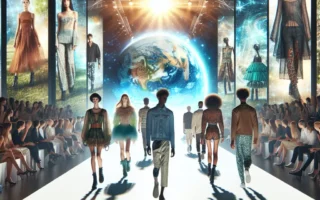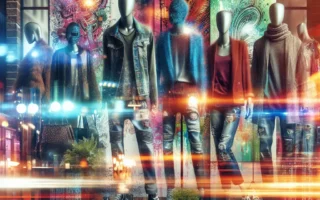Sustainable and Ethical Fashion: The Future of Style
As we move into 2021, the fashion industry is experiencing a significant shift towards sustainable and ethical practices. With the growing awareness of environmental and social issues, consumers are demanding more responsible and transparent approaches from fashion brands. This has led to a surge in sustainable and ethical fashion trends that are shaping the future of the industry.
One of the key emerging trends in 2021 is the rise of eco-friendly materials and production methods. Fashion brands are increasingly turning to innovative and sustainable materials, such as organic cotton, hemp, and recycled fabrics, to reduce their environmental impact. Additionally, there is a greater emphasis on ethical manufacturing processes, including fair labor practices and supply chain transparency.
Another important aspect of sustainable and ethical fashion is the concept of slow fashion. This movement encourages consumers to invest in high-quality, timeless pieces that are made to last, rather than following fleeting trends that promote overconsumption. Creating a more sustainable wardrobe by choosing durable, versatile garments is becoming a priority for many fashion enthusiasts.
Furthermore, the adoption of circular fashion practices is gaining momentum in 2021. This involves designing, producing, and consuming clothing in a way that minimizes waste and extends the lifespan of garments. From clothing rental and resale platforms to upcycling and recycling initiatives, the fashion industry is embracing circularity as a means to reduce its environmental footprint.
Overall, sustainable and ethical fashion is positioning itself as the future of style. In 2021, we can expect to see a greater integration of eco-friendly materials, a shift towards mindful consumption, and a continued commitment to ethical practices across the fashion industry.
Virtual Runway: How Technology is Shaping Fashion Shows
The emerging fashion trends for 2021 are taking a remarkable turn with the increasing influence of technology on fashion shows. The concept of virtual runway shows has gained substantial momentum in the industry, altering the traditional approach to presenting new collections. With the onset of the global pandemic, fashion houses and designers have swiftly adapted to digital platforms to unveil their creations. This shift has not only revolutionized the way fashion shows are conducted but has also opened up new avenues for creativity and inclusivity.
Technology is playing a pivotal role in shaping virtual runway shows, offering an immersive and interactive experience for viewers. From 3D-rendered venues to augmented reality elements, fashion shows are transcending physical limitations and embracing the digital realm. The integration of virtual reality (VR) and live streaming technologies has enabled fashion enthusiasts from around the world to attend shows in real-time, breaking geographical barriers and democratizing access to high-profile events.
Furthermore, the use of digital platforms has allowed designers to experiment with innovative presentation formats, blurring the lines between fashion, art, and technology. Interactive features such as behind-the-scenes glimpses, 360-degree views of garments, and virtual meet-and-greets with designers have enhanced viewer engagement, offering a multifaceted experience beyond the conventional runway display.
In addition to the experiential transformation, virtual runway shows have also led to sustainability benefits by significantly reducing the carbon footprint associated with traditional fashion events. The decreased need for physical infrastructure, travel, and set production has positioned digital fashion shows as a more environmentally conscious alternative.
As technology continues to shape the future of fashion shows, the synergy between creativity and innovation is expected to drive even more captivating and boundary-pushing presentations. The virtual runway is not just a temporary solution to current challenges but a fundamental evolution that is redefining the essence of fashion exhibitions.
In conclusion, the integration of technology in fashion shows is propelling the industry towards a dynamic and inclusive era, where creativity knows no bounds, and accessibility is redefined. The virtual runway is not merely a trend for 2021, but a glimpse into the transformative potential of technology in shaping the future of fashion.
Keywords: emerging fashion trends 2021, virtual runway, technology in fashion shows, digital fashion events, virtual reality in fashion, fashion industry transformation
Gender-Neutral Fashion: Redefining the Norms
As we step into 2021, the fashion landscape is witnessing a significant shift towards gender-neutral fashion, challenging the traditional norms and redefining the concept of clothing beyond stereotypes. This emerging trend is breaking barriers and celebrating inclusivity, offering a fresh perspective on self-expression and individuality.
Gender-neutral fashion embraces a fluid approach to design, blurring the lines between conventional men’s and women’s clothing. It encompasses silhouettes, colors, and styles that are not confined by traditional gender expectations, opening up a world of sartorial possibilities for everyone. Designers and brands are recognizing the importance of creating pieces that are inclusive and diverse, catering to a wide range of personal styles and identities.
As we delve into 2021, we can expect to see a surge in gender-neutral collections that prioritize comfort, functionality, and versatility. From oversized silhouettes and relaxed tailoring to androgynous prints and neutral color palettes, the focus is on creating clothing that transcends gender, allowing individuals to express themselves authentically.
Moreover, the rise of gender-neutral fashion is also reshaping the retail landscape, with an increasing number of brands embracing unisex collections and gender-fluid marketing strategies. This shift not only promotes sustainability by reducing the need for separate men’s and women’s lines but also fosters a sense of freedom and self-expression for consumers.
In conclusion, gender-neutral fashion is revolutionizing the industry, paving the way for a more inclusive and progressive approach to dressing. As we navigate through 2021, this trend is set to make a profound impact, empowering individuals to embrace clothing that truly represents who they are, regardless of gender norms.



